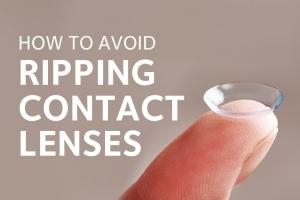It can be very frustrating to tear a contact lens. You might wonder, why can’t they just make them out of a stronger material? Currently more than 30 million Americans wear contact lenses and most of them choose soft contact lenses because the soft lens material is very comfortable and is able to let a great deal of oxygen to the cornea keeping them healthy. But this comfort comes with the price of the potential for damage. Read on to learn some tips for preventing rips in your contact lenses.
-
Avoid using fingernails–Contact lens tearing is commonly caused by using fingernails to handle lenses. When removing your lenses, use your thumb and forefinger to slide the lens to break the suction then remove. Never use your nails to pinch from the center. Keep your nails short and filed to prevent accidental nicks.
- Unfold in solution–If your lens gets folded by accident, pulling the edges apart with your fingers could result in a rip. Instead, place your lens in a pool of saline solution in the palm of your hand. Gently massage the submerged lens until the moisture helps it open without damage.
- Keep them moist–A dry lens is an easily damaged lens. Never store your lenses dry, always store them in solution. If your lenses have become dry in your eyes, use rewetting drops before taking them out. Avoid using water or any other liquid than contact solution on your lenses.
- Keep lens case full–Being conservative can be a virtue but not when it comes to filling your lens case with solution. If the case is only partially full, the lens can adhere to the dry wall, and when you go to take them out, it can cause a tear.
- Ask about the modulus– All contacts may look roughly the same, but there are variations between contact lens styles–design, oxygen permeability, material. One of the main variations is something called the modulus which is the measurement of the material’s resistance to deformation under tension. A higher modulus number means a slightly stiffer lens which is easier to handle while a lower modulus lens would tend to be floppier requiring more handling and potential for tearing. However, these lower modulus lenses, such as the Coopervision Proclear line, have a high water content and are associated with a higher comfort level. If you have an issue with your lenses tearing, ask your eye doctor about the best modulus for you.
- What to do with a torn lens– If you have torn a lens, never keep wearing it, even if it’s just a small tear along the side. Any torn edge can scratch the cornea. To remove a torn lens, wash your hands then add some rewetting solution to fully lubricate the lens preventing any bits from sticking to the eye. Pull your lower eyelid down using your thumb and forefinger and use the index finger to slide the larges part of the torn lens down to the lower part of the eye. Use your thumb and forefinger to take the lens out of your eye then examine your eye for any pieces that may remain.








